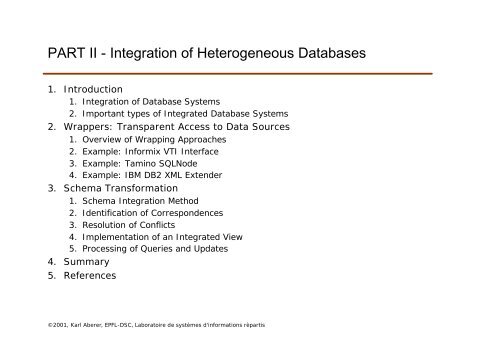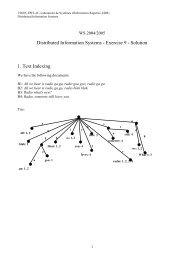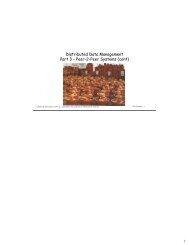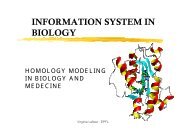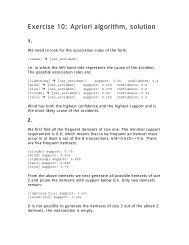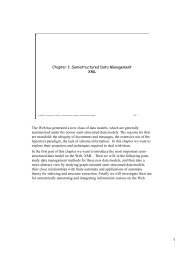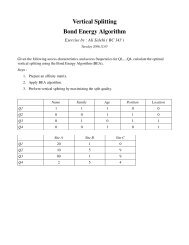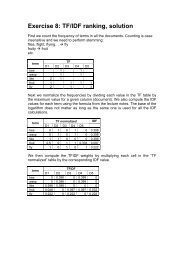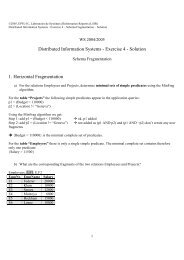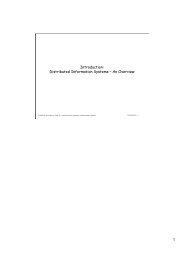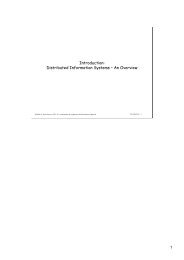PART II - Integration of Heterogeneous Databases - LSIR - EPFL
PART II - Integration of Heterogeneous Databases - LSIR - EPFL
PART II - Integration of Heterogeneous Databases - LSIR - EPFL
Create successful ePaper yourself
Turn your PDF publications into a flip-book with our unique Google optimized e-Paper software.
<strong>PART</strong> <strong>II</strong> - <strong>Integration</strong> <strong>of</strong> <strong>Heterogeneous</strong> <strong>Databases</strong><br />
1. Introduction<br />
1. <strong>Integration</strong> <strong>of</strong> Database Systems<br />
2. Important types <strong>of</strong> Integrated Database Systems<br />
2. Wrappers: Transparent Access to Data Sources<br />
1. Overview <strong>of</strong> Wrapping Approaches<br />
2. Example: Informix VTI Interface<br />
3. Example: Tamino SQLNode<br />
4. Example: IBM DB2 XML Extender<br />
3. Schema Transformation<br />
1. Schema <strong>Integration</strong> Method<br />
2. Identification <strong>of</strong> Correspondences<br />
3. Resolution <strong>of</strong> Conflicts<br />
4. Implementation <strong>of</strong> an Integrated View<br />
5. Processing <strong>of</strong> Queries and Updates<br />
4. Summary<br />
5. References<br />
©2001, Karl Aberer, <strong>EPFL</strong>-DSC, Laboratoire de systèmes d'informations rèpartis
1 Introduction<br />
• 1.1 <strong>Integration</strong> <strong>of</strong> Database Systems<br />
• 1.2 Important Types <strong>of</strong> Integrated Database Systems<br />
©2001, Karl Aberer, <strong>EPFL</strong>-DSC, Laboratoire de systèmes d'informations rèpartis
1.1 <strong>Integration</strong> <strong>of</strong> <strong>Databases</strong><br />
• A frequent problem in information systems development is the integration<br />
<strong>of</strong> existing information sources<br />
• Example: <strong>Integration</strong> <strong>of</strong> publication data<br />
– Web resources: e.g. DB Server in Trier, CiteSeer citation index<br />
– Local bibliography: e.g. MS Access application for lab library<br />
– University library server: e.g. Oracle database application<br />
– Private bibliography: e.g. BibTex file, MS Word document<br />
• Goals<br />
– Maintain consistent data<br />
– Perform queries over all databases at once<br />
– Perform updates only once<br />
• Problems<br />
– Establishing communication<br />
– Different data models<br />
– Different data schemas and representation<br />
– Different processing capabilities<br />
©2001, Karl Aberer, <strong>EPFL</strong>-DSC, Laboratoire de systèmes d'informations rèpartis
Fundamental Dimensions in Distributed Information<br />
Systems<br />
Distribution<br />
Distributed<br />
DBMS<br />
WWW<br />
WWW-Mirrors<br />
Federated databases<br />
(Multidatabases)<br />
Autonomy<br />
Centralized<br />
DBMS<br />
Heterogeneity<br />
©2001, Karl Aberer, <strong>EPFL</strong>-DSC, Laboratoire de systèmes d'informations rèpartis
Heterogeneity<br />
• Autonomous development <strong>of</strong> information systems leads naturally to<br />
different solutions for the same problems<br />
– A main problem in information systems integration<br />
• Levels <strong>of</strong> heterogeneity<br />
– syntactic<br />
– semantic<br />
• Syntactical heterogeneity<br />
– Communication interface<br />
• Access protocols: http, CORBA, SQL, ODBC, ….<br />
• Stateless- or stateful connections<br />
• Security and admission procedures<br />
– Data models<br />
• Relational, XML, object-oriented, …<br />
– Functionality <strong>of</strong> access methods<br />
• Different scope and expressibility <strong>of</strong> query languages<br />
• Restrictions on query types (e.g. joins, binding <strong>of</strong> variables)<br />
• Semantic heterogeneity<br />
– The semantics <strong>of</strong> the models do not coincide<br />
– The semantics coincides but the structural representation differs<br />
– The representation is the same but the extensions differ<br />
©2001, Karl Aberer, <strong>EPFL</strong>-DSC, Laboratoire de systèmes d'informations rèpartis
Autonomy<br />
• Autonomy requirement<br />
– The local operation <strong>of</strong> a system and system consistency is not affected by its<br />
participation in a global system<br />
• 1. Design autonomy<br />
– Each system can model its data and processes using the preferred models and in<br />
the preferred way<br />
– This may lead to heterogeneity in data processing models that need to be<br />
overcome by intermediate layers<br />
• 2. Execution autonomy<br />
– Each system can execute operations that are requested in the preferred way<br />
– This may lead to inconsistent executions <strong>of</strong> operations and requires means to<br />
recognize and compensate (-> later: distributed transactions)<br />
• 3. Communication autonomy<br />
– Each system is free to decide when and to what provide access to its resources<br />
– This may lead to incomplete access to resources and thus limit the capabilities <strong>of</strong><br />
the global system (-> later: distributed objects)<br />
• Semiautonomous systems<br />
– Give up some <strong>of</strong> their autonomy to participate in a global system (contract)<br />
©2001, Karl Aberer, <strong>EPFL</strong>-DSC, Laboratoire de systèmes d'informations rèpartis
1.2 Important Types <strong>of</strong> Integrated Database Systems<br />
• Multidatabases<br />
• Federated <strong>Databases</strong><br />
• Mediator Systems<br />
• Data Warehouses<br />
©2001, Karl Aberer, <strong>EPFL</strong>-DSC, Laboratoire de systèmes d'informations rèpartis
Multidatabases<br />
• Enable transparent access to multiple databases, loose coupling<br />
– Hide distribution, different database language variants<br />
– Process queries and updates against multiple databases<br />
– Do not hide the different database schemas<br />
©2001, Karl Aberer, <strong>EPFL</strong>-DSC, Laboratoire de systèmes d'informations rèpartis<br />
Source: IBM
Federated <strong>Databases</strong><br />
• Export Schema<br />
– Unifies data model<br />
– Enriches access functions<br />
• Import Schema<br />
– view on export schema<br />
• Integrated schema<br />
– Homogenizes and unions import schemas<br />
– Virtual vs. materialized<br />
– Predefined vs. constructed<br />
• Views<br />
– as in centralized DBMS<br />
View 1 View 2 View 3<br />
Import<br />
Schema<br />
Export<br />
Schema<br />
Integrated Schema<br />
Import<br />
Schema<br />
Export<br />
Schema<br />
Import<br />
Schema<br />
Export<br />
Schema<br />
...<br />
Import<br />
Schema<br />
Export<br />
Schema<br />
Relational.<br />
DBMS<br />
Objectorient.<br />
DBMS<br />
Web<br />
Server<br />
File<br />
System<br />
©2001, Karl Aberer, <strong>EPFL</strong>-DSC, Laboratoire de systèmes d'informations rèpartis
Mediator Systems<br />
• Main differences to federated databases<br />
– Read-only access<br />
– Non-database resources<br />
– Light-weight and flexible<br />
©2001, Karl Aberer, <strong>EPFL</strong>-DSC, Laboratoire de systèmes d'informations rèpartis<br />
Source: Kutsche
Data Warehouses<br />
• Are a specialized form <strong>of</strong> federated database system, where the integrated<br />
database is materialized<br />
– perform efficient data analysis<br />
– OLAP (on-line analytical processing)<br />
– Data mining<br />
• Uses typically limited forms <strong>of</strong> database schemas (e.g. relational star<br />
schemas)<br />
– Supports multidimensional data model<br />
• Main problems<br />
– Updates and data consistency<br />
– Wrapper development<br />
– Efficient processing <strong>of</strong> OLAP and data mining queries<br />
Source<br />
databases<br />
Source<br />
databases<br />
Source<br />
databases<br />
integrate<br />
Central<br />
Data warehouse<br />
Metadata<br />
extract<br />
extract<br />
Datamart<br />
Datamart<br />
query<br />
query<br />
OLAP and mining<br />
tools<br />
OLAP and mining<br />
tools<br />
©2001, Karl Aberer, <strong>EPFL</strong>-DSC, Laboratoire de systèmes d'informations rèpartis
Aspects to Consider for <strong>Integration</strong><br />
• General issues<br />
– Bottom-up vs. top-down engineering<br />
• from existing schema to integrated and vice versa<br />
– A priori vs. a posteriori integration<br />
– Virtual vs. materialized integration<br />
– Read-only vs. read-write access<br />
• Data model related issues<br />
– Type <strong>of</strong> sources<br />
• structured, semi-structured, unstructured<br />
– Data model <strong>of</strong> integrated system<br />
• canonical data model<br />
– Tight vs. loose integration<br />
• global schema<br />
– Support for semantic integration<br />
• collection, fusion, abstraction, supplementation<br />
– Transparency<br />
• language, schema, location<br />
– Query model<br />
©2001, Karl Aberer, <strong>EPFL</strong>-DSC, Laboratoire de systèmes d'informations rèpartis
Properties <strong>of</strong> Integrated Information Systems (typical)<br />
Multidatabases<br />
Federated<br />
databases<br />
Mediator<br />
Systems<br />
Data<br />
Warehouses<br />
Bottom-up vs. top-down<br />
none<br />
bottom-up<br />
top-down<br />
bottom-up<br />
Virtual vs. materialized<br />
virtual<br />
virtual<br />
virtual<br />
materialized<br />
Read-only vs. read-write<br />
read-write<br />
read-write<br />
read-only<br />
read-only<br />
Type <strong>of</strong> sources<br />
structured<br />
structured<br />
all<br />
all<br />
Canonical data model<br />
relational<br />
relational,<br />
objectoriented<br />
multidimensional<br />
semistructured,<br />
XML<br />
Global schema<br />
no<br />
yes<br />
yes<br />
yes<br />
Support for semantic<br />
integration<br />
collection<br />
collection,<br />
fusion<br />
collection,<br />
fusion,<br />
abstraction<br />
collection,<br />
fusion,<br />
aggregation<br />
Transparency<br />
(location),<br />
language<br />
location,<br />
schema,<br />
language<br />
location,<br />
schema,<br />
language<br />
location,<br />
schema,<br />
language<br />
Query model<br />
SQL<br />
SQL<br />
Rule-based<br />
OLAP<br />
©2001, Karl Aberer, <strong>EPFL</strong>-DSC, Laboratoire de systèmes d'informations rèpartis
2 Wrappers<br />
• 2.1 Overview <strong>of</strong> Wrapping Approaches<br />
• 2.2 Example: Informix VTI Interface<br />
• 2.3 Example: Tamino SQLNode<br />
• 2.4 Example: Extensible <strong>Databases</strong> (IBM DB2)<br />
©2001, Karl Aberer, <strong>EPFL</strong>-DSC, Laboratoire de systèmes d'informations rèpartis
2. 1 Wrappers: Transparent Access to Data Sources<br />
• Wrappers are s<strong>of</strong>tware to overcome syntactic heterogeneity<br />
(communication, data model, functionality)<br />
request/query<br />
result/data<br />
compensation<br />
for missing<br />
processing<br />
capabilities<br />
Transformation<br />
<strong>of</strong> data model<br />
Communication<br />
interface<br />
Source data<br />
©2001, Karl Aberer, <strong>EPFL</strong>-DSC, Laboratoire de systèmes d'informations rèpartis
Mappings between Different Data Models<br />
• Different data models support different data types and type constructors<br />
• Mappings from a "simple" model (fewer, less powerful constructors) to a<br />
"complex" model are straightforward<br />
– e.g. from relational to object-oriented or XML-Schema<br />
• The other direction is always possible, but comes with a loss in<br />
– constraints: not all constraints that are modelled are maintained<br />
• i.e. the new model may fit inconsistent data<br />
– performance: Since the structure <strong>of</strong> a schema is usually exploited for optimization<br />
• Also the differences in processing capabilities, e.g. constraints, queries,<br />
need to be considered<br />
– e.g. relational is more powerful than XML<br />
©2001, Karl Aberer, <strong>EPFL</strong>-DSC, Laboratoire de systèmes d'informations rèpartis
Example: Generic Mapping <strong>of</strong> Relational Data into XML<br />
• The mapping <strong>of</strong> a relational table instance R(A1, …, An) into an XML<br />
structure is straightforward<br />
• The problem is<br />
– Which constraints can be maintained <br />
– What query processing capabilities are available <br />
– E.g. joins are missing<br />
• XML Schema + XML Query<br />
– Should solve many <strong>of</strong> these problems !<br />
©2001, Karl Aberer, <strong>EPFL</strong>-DSC, Laboratoire de systèmes d'informations rèpartis
Example: Generic Mapping <strong>of</strong> XML Data into Relational<br />
• Sample source document<br />
Doc1 Doc2 Doc3<br />
0<br />
2<br />
9<br />
1 3 5 7<br />
Text <strong>of</strong> Elem1<br />
10<br />
Text <strong>of</strong> Elem10<br />
4<br />
6 8<br />
Text <strong>of</strong> Elem4 Text <strong>of</strong> Elem6 Text <strong>of</strong> Elem8<br />
©2001, Karl Aberer, <strong>EPFL</strong>-DSC, Laboratoire de systèmes d'informations rèpartis
Example: Generic Mapping <strong>of</strong> XML Data into Relational<br />
• Also this can be done in several straightforward ways, e.g.<br />
FlatElemTable<br />
DocElemTable<br />
DocumentTable<br />
flat<br />
own_id doc up succ pred own_id name dtdref root<br />
"Text <strong>of</strong> Elem1" 0 1 - - - 1 "Doc1" 2 0<br />
"Text <strong>of</strong> Elem4" 1 1 0 - - 2 "Doc2" 1 2<br />
"Text <strong>of</strong> Elem6" 2 2 - - - 3 "Doc3" 1 9<br />
"Text <strong>of</strong> Elem8" 3 2 2 5 -<br />
"Text <strong>of</strong> Elem10" 4 2 3 - -<br />
5 2 2 7 3 attrRecTable<br />
6 2 5 - - element name value<br />
NonFlatElemTable 7 2 2 - 5 2 Attr2 AW2<br />
down etName 8 2 7 - - 3 Attr3 AW3<br />
1 "E0" 9 3 - - -<br />
3 "E2" 10 3 9 - - DocumentTypeTable<br />
4 "E3" own_id name etypes config<br />
6 "E5" 1 "DTD1" {...} "...."<br />
8 "E7" 2 "DTD2" {...} "...."<br />
10 "E9" 3 "DTD3" {...} "...."<br />
• Problems: structural constraints are lost<br />
– need to be dynamically reconstructed (efficiency!)<br />
– Consistency <strong>of</strong> data needs to be checked in addition<br />
©2001, Karl Aberer, <strong>EPFL</strong>-DSC, Laboratoire de systèmes d'informations rèpartis
Categories <strong>of</strong> Wrappers<br />
• There exists no standard approach to build wrappers<br />
• Functionality<br />
– One-way: only transformation <strong>of</strong> data (e.g. for data warehouses)<br />
– Two-way: transformation <strong>of</strong> requests and data<br />
• Development<br />
– Hard-wired wrappers, for specific data sources<br />
– Semi-automatic generation: wrapper development tools<br />
– Automatically generated wrappers<br />
• Availability<br />
– Standalone programs for data conversion<br />
– Modules within a federated DBMS<br />
– Exploiting integral functionality <strong>of</strong> DBMS (extensibe DBMS)<br />
©2001, Karl Aberer, <strong>EPFL</strong>-DSC, Laboratoire de systèmes d'informations rèpartis
Data Conversion Tools<br />
• In practice data conversion tools are specific s<strong>of</strong>tware that<br />
– support many different formats<br />
– perform standard conversions semi-automatically<br />
– allow definition <strong>of</strong> complex conversion logic<br />
– maintain a repository <strong>of</strong> conversion methods<br />
• Examples<br />
– Micros<strong>of</strong>t data import tools<br />
– XMLJunction<br />
– XSLT is also considered as a possible solution to convert XML data, e.g.<br />
conversion <strong>of</strong> XML databases into relational<br />
©2001, Karl Aberer, <strong>EPFL</strong>-DSC, Laboratoire de systèmes d'informations rèpartis
Relational Database Middleware<br />
• A number <strong>of</strong> products (IBM DataJoiner, Miracle, EDS) allow to access<br />
multiple relational databases (from different vendors)<br />
– Thus a multidatabase system<br />
– Tables in foreign databases can be accessed like local tables<br />
– 2 phase commit for transactions (updates)<br />
– Optimization <strong>of</strong> queries, pushing down <strong>of</strong> subqueries<br />
• Address fully syntactic heterogeneity for relational DBs<br />
– Location transparanecy<br />
– SQL dialect transparency<br />
– Error code transparency<br />
– Data type transparency<br />
©2001, Karl Aberer, <strong>EPFL</strong>-DSC, Laboratoire de systèmes d'informations rèpartis
Database Interfaces for Foreign Data<br />
• Some database products allow to define user-defined mappings to data<br />
from arbitrary sources<br />
– Data appears like local data<br />
– Mapping includes (some) compensation for missing functions at the source<br />
• Examples<br />
– Informix' Virtual Table Interface (VTI)<br />
• Any data to relational data<br />
– Tamino's SQLNode<br />
• relational data to XML data<br />
– IBM DB2 XML Extender<br />
• XML data to relational data<br />
©2001, Karl Aberer, <strong>EPFL</strong>-DSC, Laboratoire de systèmes d'informations rèpartis
2.2 Informix Virtual Table Interface<br />
• When a relational query is processed it is transformed into a sequence <strong>of</strong><br />
calls to the storage system, for example<br />
– SELECT * FROM publications<br />
translates to<br />
TABLEDESCRIPTION* Table;<br />
SCANDESCRIPTION* Scan;<br />
ROW* Record;<br />
Table := OpenTable(Publications);<br />
Scan := BeginScan(Table);<br />
while (( record := NextScan(Table)) != END-OF-SCAN) {process record};<br />
EndScan(Scan);<br />
CloseTable(Table);<br />
• If external data should appear like relational it has to support VTI functions<br />
(see table)<br />
– By providing and registering those functions any data can be integrated<br />
– Already a partial implementation can be sufficient (with less performance)<br />
©2001, Karl Aberer, <strong>EPFL</strong>-DSC, Laboratoire de systèmes d'informations rèpartis
VTI functions<br />
©2001, Karl Aberer, <strong>EPFL</strong>-DSC, Laboratoire de systèmes d'informations rèpartis<br />
Source: DE Bulletin Vol 21
2.3 Tamino<br />
©2001, Karl Aberer, <strong>EPFL</strong>-DSC, Laboratoire de systèmes d'informations rèpartis<br />
Source: SAG
Tamino Schema Language<br />
• Proprietary, XML-based Schema Language<br />
– Hierarchical XML structure<br />
– Processing-related attributes<br />
– No recursive definition possible<br />
– <strong>Integration</strong> <strong>of</strong> external data sources<br />
©2001, Karl Aberer, <strong>EPFL</strong>-DSC, Laboratoire de systèmes d'informations rèpartis<br />
Source: SAG
Integrating Relational Data Into Tamino<br />
• Tamino allows to populate an XML document from a relational databases<br />
– Definition <strong>of</strong> a DTD<br />
– Transformation to Tamino's schema language<br />
– Setting <strong>of</strong> attribute values that specify <strong>of</strong> how the data is accessed in the RDBMS<br />
©2001, Karl Aberer, <strong>EPFL</strong>-DSC, Laboratoire de systèmes d'informations rèpartis<br />
Source: SAG
Integrating Relational Data Into Tamino<br />
©2001, Karl Aberer, <strong>EPFL</strong>-DSC, Laboratoire de systèmes d'informations rèpartis<br />
Source: SAG
2.4 Wrapping with Extensible <strong>Databases</strong><br />
• Extensible databases (object-oriented, object-relational), allow to define<br />
new datatypes within the data model<br />
– Can be used to directly integrate external data<br />
– <strong>Integration</strong> is not transparent, i.e. integrated data does not appear like native<br />
data<br />
• Example: integration <strong>of</strong> XML data into relational database<br />
– IBM DB2 XML extender<br />
• Storage options<br />
– As character string (XMLCLOB, XMLVARCHAR)<br />
– As external file (XMLFILE)<br />
– As set <strong>of</strong> relational tables that are mapped to an XML document<br />
• Indexing<br />
– When the document is stored as a whole, selected elements and attributes can be<br />
extracted into tables and indexed<br />
– Textual indexing using the text extender<br />
• Mappings<br />
– From/to relational tables are specified using XPath and XSLT<br />
©2001, Karl Aberer, <strong>EPFL</strong>-DSC, Laboratoire de systèmes d'informations rèpartis
Example: XML DTD<br />
©2001, Karl Aberer, <strong>EPFL</strong>-DSC, Laboratoire de systèmes d'informations rèpartis<br />
Source: IBM
Example: Access using IBM DB2 Extender<br />
• Relational schema<br />
TABLE sales_tab<br />
invoice_nr<br />
sales_person<br />
order<br />
CHAR(6) NOT NULL PRIMARY KEY<br />
VARCHAR(20)<br />
XMLVARCHAR<br />
• Indexing element extendedprice using table part_side_table<br />
• Querying<br />
SELECT sales_person FROM sales_tab<br />
WHERE invoice_nr in<br />
(SELECT invoice_nr FROM part_sidetable<br />
WHERE extendedprice>2500)<br />
• Querying a "hidden" XML element using XPath (expensive)<br />
SELECT sales_person FROM sales_tab<br />
WHERE extractvarchar(order, '/Order/Customer') like '%IBM%'<br />
AND invoice_number>100<br />
©2001, Karl Aberer, <strong>EPFL</strong>-DSC, Laboratoire de systèmes d'informations rèpartis
3 Schema Transformation<br />
• 3.1 Schema <strong>Integration</strong> Method<br />
• 3.2 Identification <strong>of</strong> Correspondences<br />
• 3.3 Resolution <strong>of</strong> Conflicts<br />
• 3.4 Implementation <strong>of</strong> an Integrated View<br />
• 3.5 Processing <strong>of</strong> Queries and Updates<br />
©2001, Karl Aberer, <strong>EPFL</strong>-DSC, Laboratoire de systèmes d'informations rèpartis
3.1 Schema Transformation Method<br />
• Creation <strong>of</strong> an integrated view <strong>of</strong> the data<br />
– Useful to make heterogeneity transparent for applications<br />
– Data from the different sources can be complementary or overlapping<br />
– Problem: the same data can be represented in various ways<br />
– Requires schema mappings that overcome the differences (schema integration)<br />
– Requires the capability to process query against the integrated schema<br />
• <strong>Integration</strong> Method<br />
Schema translation<br />
(wrapper)<br />
Correspondence<br />
investigation<br />
Conflict resolution<br />
and schema integration<br />
©2001, Karl Aberer, <strong>EPFL</strong>-DSC, Laboratoire de systèmes d'informations rèpartis
Criteria for the Quality <strong>of</strong> an <strong>Integration</strong> Method<br />
• Completeness<br />
– Integrated schema contains all concepts <strong>of</strong> component schemas<br />
– no loss <strong>of</strong> information: data and constraints<br />
• Minimality<br />
– The same real world concept represented in multiple component schemas must<br />
be represented only once<br />
• Correctness<br />
– All information in the integrated schema must occur in one <strong>of</strong> the component<br />
schemas<br />
– New relations among different schema concepts (inter-schema-relations) must<br />
not contradict information from component schemas<br />
• Understandability<br />
– Integrated schema must be easily understandable<br />
©2001, Karl Aberer, <strong>EPFL</strong>-DSC, Laboratoire de systèmes d'informations rèpartis
3.2 Identification <strong>of</strong> Correspondences<br />
• Find out which two concepts in two schemas correspond to each other<br />
– no automatic solution possible<br />
– Manual or semi-automatic approach<br />
• Semi-automatic approaches<br />
– analyse semantic correspondences (names)<br />
– analyse structural correspondences (e.g. reachability by paths)<br />
– analyse data (e.g. distribution <strong>of</strong> values)<br />
• Sources for missing information<br />
– database administrator, developer<br />
– analysis <strong>of</strong> the source schemas<br />
– analysis <strong>of</strong> the source databases<br />
– anaylsis <strong>of</strong> the source applications<br />
©2001, Karl Aberer, <strong>EPFL</strong>-DSC, Laboratoire de systèmes d'informations rèpartis
Example: <strong>Integration</strong> <strong>of</strong> Two Relational Schemata<br />
• SCHEMA 1<br />
PUBLICATIONS(PNR, TITLE, AUTHOR, JOURNAL, PAGES)<br />
AUTHORS(ANR, TITLE, NAME, AFFILIATION)<br />
JOURNAL(JNR, NAME, PUBLISHER, ISSUE, MONTH, YEAR)<br />
• SCHEMA 2<br />
PAPERS(NUMBER, TITLE, WRITER, PUBLISHED)<br />
WRITER(FIRSTNAME, LASTNAME, NROFPUBLICATIONS)<br />
PUBLISHED(TYPE, PROCEEDINGS, PP, DATE)<br />
©2001, Karl Aberer, <strong>EPFL</strong>-DSC, Laboratoire de systèmes d'informations rèpartis
Example: Detecting Correspondences<br />
• Analysis <strong>of</strong> relation and attribute names (semantic correspondences)<br />
– C1: S1.PUBLICATIONS related to S2.PAPERS (relevant)<br />
– C2: S1.AUTHORS.TITLE related to S2.PAPERS.TITLE (irrelevant)<br />
– C3: S1.PUBLICATIONS.TITLE related to S2.PAPERS.TITLE (relevant)<br />
• Analysis <strong>of</strong> structural correspondences<br />
– Shows that C3 is more relevant than C2<br />
– S1.PUBLICATIONS.TITLE related to S2.PAPERS.TITLE<br />
• same path leads to TITLE<br />
– S1.AUTHORS.TITLE not related to S2.PAPERS.TITLE<br />
• different path leads to TITLE<br />
– Shows a further relatinoship: S1.JOURNALS.YEAR related to S2.PUBLISHED.YR<br />
since both share the data type DATE<br />
• Analysis <strong>of</strong> data values<br />
– S1.PUBLICATIONS.PAGES related to S2.PUBLISHED.PP<br />
– Both attributes contain always two substrings that are up to 3 digit numbers<br />
©2001, Karl Aberer, <strong>EPFL</strong>-DSC, Laboratoire de systèmes d'informations rèpartis
3.3 Resolution <strong>of</strong> Conflicts<br />
• Types <strong>of</strong> conflicts encountered at schema level<br />
– Naming conflicts<br />
– Structural conflicts<br />
– Classification conflicts<br />
– Constraint conflicts<br />
– Behavioral conflicts<br />
– Data conflicts<br />
• Types <strong>of</strong> conflicts encountered at data level<br />
– Naming conflicts<br />
– Representational conflicts<br />
– Errors<br />
©2001, Karl Aberer, <strong>EPFL</strong>-DSC, Laboratoire de systèmes d'informations rèpartis
Naming Conflicts: Homonyms and Synonyms<br />
• Homonyms<br />
– same term used for different concepts,<br />
– e.g. S1.AUTHORS.TITLE vs. S2.PAPERS.TITLE<br />
– Resolution: introduce prefixes to distinguish the names,<br />
– e.g. A_TITLE and P_TITLE<br />
• Synonyms<br />
– different terms for the same concepts, e.g.<br />
– S1.PUBLICATIONS.AUTHOR vs. S2.PAPERS.WRITER<br />
– Resolution: introduce a mapping to a common attribute<br />
• Use <strong>of</strong> Ontologies and Thesauri to detect and resolve naming conflicts<br />
©2001, Karl Aberer, <strong>EPFL</strong>-DSC, Laboratoire de systèmes d'informations rèpartis
Structural Conflicts<br />
• Same concept represented by different data structures<br />
– More probable the "richer" the data model is (e.g. object-oriented vs. relational)<br />
– Kind <strong>of</strong> conflicts depends on data model<br />
• Example 1: Different attributes<br />
– S1.AUTHORS.AFFILIATION and S2.WRITER.NROFPUBLICATIONS have no<br />
corresponding attributes in the other schema<br />
– Resolution: create a relation with the union <strong>of</strong> the attributes<br />
• Example 2: Different datatypes<br />
– S1.JOURNAL.MONTH and S1.JOURNAL.YEAR contain together the same information<br />
as S2.PUBLISHED.DATE<br />
– Resolution: build a mapping function, e.g. DATE(MONTH, YEAR)<br />
• Example 3: Different data model constructs<br />
– attribute vs. relation: S2.PUBLISHED.TYPE="Journal" means that the publication<br />
is a journal, while S1.JOURNALS contains only journals<br />
– Resolution: requires higher order mapping languages that can manipulate<br />
database schemas directly<br />
©2001, Karl Aberer, <strong>EPFL</strong>-DSC, Laboratoire de systèmes d'informations rèpartis
Classification Conflicts<br />
• Extensions <strong>of</strong> concept are different<br />
– Modelling constructs A and B that are recognized as corresponding can cover sets<br />
with different scopes<br />
– All possible set relationships<br />
• A=B: equivalent sets<br />
• A⊆B: A is a subset <strong>of</strong> B<br />
• A∩B: A and B have some elements in common<br />
• A≠B: A and B have no elements in common<br />
• Example<br />
– S1.AUTHORS are authors <strong>of</strong> journal papers only<br />
– S2.WRITERS contains also authors <strong>of</strong> other types <strong>of</strong> publications<br />
• Resolution<br />
– build generalization hierarchies<br />
– requires data model with inheritance, e.g. object-oriented<br />
• Additional problem<br />
– Identification <strong>of</strong> corresponding data instances<br />
– "real world" correspondence is application dependent<br />
– Example: check the reliability <strong>of</strong> the bibliographic references in the two<br />
databases, and in case <strong>of</strong> error to trace back to the source <strong>of</strong> error<br />
©2001, Karl Aberer, <strong>EPFL</strong>-DSC, Laboratoire de systèmes d'informations rèpartis
Constraint and Behavioral Conflicts<br />
• Depend on the expressivity <strong>of</strong> the data model<br />
– Relational model: key constraints, update and delete behavior<br />
– Object-oriented model: cardinality constraints, methods<br />
• Example 1: Primary key conflicts<br />
– S1.PUBLICATIONS.PNR is another numbering scheme than S2.PAPERS.NUMBER<br />
– Resolution: introduce a mapping table<br />
• Example 2: Cardinality conflicts<br />
– different types <strong>of</strong> cardinality constraints on relationships<br />
– Resolution: use the more general constraint<br />
• Example 3: Behavioral conflicts for relation update<br />
– E.g. cascading delete vs. non-cascading<br />
– Resolution: add missing behavior at global level<br />
• Example 4: Method conflicts<br />
– Different methods or user-defined functions supported<br />
– Resolution: implement methods at global level<br />
©2001, Karl Aberer, <strong>EPFL</strong>-DSC, Laboratoire de systèmes d'informations rèpartis
Data Conflicts and Resolution Strategies<br />
• Even if all conflicts at the schematic level are resolved, the question<br />
remains which data values correspond to each other<br />
– E.g. two authors are the same if they share the same name <br />
– Problems: similar to naming conflicts at schema level<br />
• Same author may have different names in the databases, e.g.<br />
"Aberer, K.H." in DB1 and "Karl Aberer" in DB2<br />
• Different authors may share the same names, e.g.<br />
"Xu, Y." in DB1 (uniqely identified by ANR) may be "Yi Xu", "Yang Xu", "Ying Xu", … in<br />
DB2<br />
– Applies to all atomic data types<br />
• E.g. representation <strong>of</strong> dates: e.g. "2000" va. "00"<br />
• Resolution<br />
– Provide an extensional mapping table for all data values<br />
• Possible for restricted data domains, e.g. "Vaud" -> "VD", "Zürich" -> "ZH", …<br />
– Provide a mapping function<br />
• If computable, e.g. four digit year to two digit year<br />
– Use a similarity function<br />
• Compensate for typing errors or variations, e.g. "Chemin d. Monteiron" vs. "Chemin du<br />
Monteron"<br />
– Prefer data from one data source<br />
• The one that is more trusted<br />
• Usually domain specific knowledge is required !<br />
©2001, Karl Aberer, <strong>EPFL</strong>-DSC, Laboratoire de systèmes d'informations rèpartis
3.4 Implementation <strong>of</strong> an Integrated View<br />
• Use <strong>of</strong> a DML (e.g. SQL)<br />
– approach used in multidatabases, like Data Joiner<br />
– problem: only sufficient to create the integrated view for simple cases<br />
• Procedural programming language<br />
– with access to the DDL<br />
– problem: general, but no support for developing consistent transformations<br />
• Extensible databases (e.g. object-relational or OODBs)<br />
– provide more complex DML constructs, DDL instructions and can in addition<br />
integrate functions to compute any mapping<br />
– object-oriented models (including object-relational) are the preferred canonical<br />
models for database integration<br />
– problems: complexity, consistency, design methodology, …<br />
• Declarative languages (e.g. predicate logic based, rule based)<br />
– most promising approach<br />
– problem: are currently available in research prototypes only<br />
©2001, Karl Aberer, <strong>EPFL</strong>-DSC, Laboratoire de systèmes d'informations rèpartis
Example: Implementation <strong>of</strong> an Integrated View in SQL<br />
• Integrated view on AUTHORS and WRITERS<br />
– Assume identical instances in AUTHORS and WRITERS are identified through a<br />
mapping table<br />
mapping(firstname, lastname, anr)<br />
– Implementation in MS ACCESS SQL (barely !) doable<br />
SELECT<br />
[s2_writer.firstname] & " " & [s2_writer.lastname] AS name, (1)<br />
Null AS title, Null AS affiliation, Null AS anr, (2)<br />
s2_writer.nr<strong>of</strong>publications<br />
FROM s2_writer, mapping WHERE<br />
[s2_writer.firstname] & " " & [s2_writer.lastname] NOT IN (3)<br />
(SELECT [firstname] & " " & [lastname] FROM mapping)<br />
UNION (4)<br />
SELECT s1_authors.name, s1_authors.title, s1_authors.affiliation,<br />
s1_authors.anr, Null AS nr<strong>of</strong>publications<br />
FROM s1_authors LEFT JOIN mapping ON s1_authors.anr = mapping.anr; (5)<br />
©2001, Karl Aberer, <strong>EPFL</strong>-DSC, Laboratoire de systèmes d'informations rèpartis
Example: Explanations<br />
• Comments<br />
1. Resolution <strong>of</strong> the use <strong>of</strong> different data structures by combining textual fields<br />
2. Resolution <strong>of</strong> the use <strong>of</strong> different attributes by including all attributes into the<br />
integrated view<br />
3. Exclusion <strong>of</strong> the instances with occurrence in both tables<br />
4. Union <strong>of</strong> the both tables, resolution <strong>of</strong> different coverage<br />
5. Identification <strong>of</strong> corresponding instances<br />
©2001, Karl Aberer, <strong>EPFL</strong>-DSC, Laboratoire de systèmes d'informations rèpartis
3.5 Processing <strong>of</strong> Queries<br />
• Issues<br />
– Automatic resolution <strong>of</strong><br />
schema mapping<br />
– Optimization <strong>of</strong> access<br />
©2001, Karl Aberer, <strong>EPFL</strong>-DSC, Laboratoire de systèmes d'informations rèpartis<br />
Source: Kutsche
Propagation <strong>of</strong> Updates<br />
• If the mappings are not injective updates cannot be propagated<br />
– For the same reason SQL restricts view updates<br />
– No problem in multidatabases, as each external table is integrated separately<br />
• Example<br />
– The resulting table <strong>of</strong> the previous example has the structure<br />
integrated_authors(name, title, affiliation, anr, nr<strong>of</strong>publications)<br />
– The following updates on the integrated view do not have always a well-defined<br />
semantics (meaning)<br />
– Why (appart from the fact that updates are principally not possible in SQL for this<br />
view) <br />
• Inserting a tuple<br />
• Updating the name<br />
• Updating the title (<strong>of</strong> the author !)<br />
©2001, Karl Aberer, <strong>EPFL</strong>-DSC, Laboratoire de systèmes d'informations rèpartis
4. Summary<br />
• Syntactic heterogeneity, communication and transaction problems have<br />
many solutions<br />
– Database Middleware<br />
– XML technology<br />
– Distributed objects<br />
– Transaction monitors<br />
• Semantic heterogeneity remains a difficult problem<br />
• Current developments<br />
– Use <strong>of</strong> more sophisticated knowledge-based tools, e.g. ontologies, declarative<br />
approaches<br />
– Logic language based approaches<br />
– Light-weight mediation on the Web based on XML technology<br />
• Many <strong>of</strong> the heterogeneity problems illustrated for DBs also hold for<br />
application objects (except, e.g., the extensional aspects)<br />
©2001, Karl Aberer, <strong>EPFL</strong>-DSC, Laboratoire de systèmes d'informations rèpartis
5. References<br />
• Books<br />
– Özsu, Valduriez: Principles <strong>of</strong> Distributed Database Sytems, Second Edition,<br />
Prentice Hall, 1999.<br />
• Articles<br />
– S. Busse, R.-D. Kutsche, U. Leser, H. Weber, Federated Information Systems:<br />
concepts, terminology and architectures, Technical Report Nr. 99-9, TU Berlin,<br />
1999.<br />
– IEEE Data Engineering Bulletin, Volume 21, Number 3, September 1998, Special<br />
Issue on Interoperability.<br />
– Stefano Spaccapietra, Christine Parent, Yann Dupont: Model Independent<br />
Assertions for <strong>Integration</strong> <strong>of</strong> <strong>Heterogeneous</strong> Schemas. VLDB Journal 1(1): 81-126<br />
(1992).<br />
– Fernando de Ferreira Rezende, Klaudia Hergula: The Heterogeneity Problem and<br />
Middleware Technology: Experiences with and Performance <strong>of</strong> Database<br />
Gateways. VLDB 1998: 146-157.<br />
• Websites<br />
– www-4.ibm.com/s<strong>of</strong>tware/data/datajoiner/<br />
– ibm.com/s<strong>of</strong>tware/data/db2/extenders/xmlext<br />
– www.s<strong>of</strong>twareag.com/germany/products/xmlstarterkit.htm<br />
©2001, Karl Aberer, <strong>EPFL</strong>-DSC, Laboratoire de systèmes d'informations rèpartis


